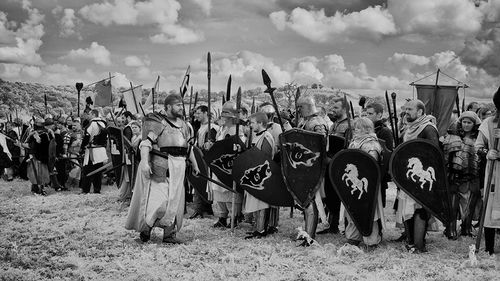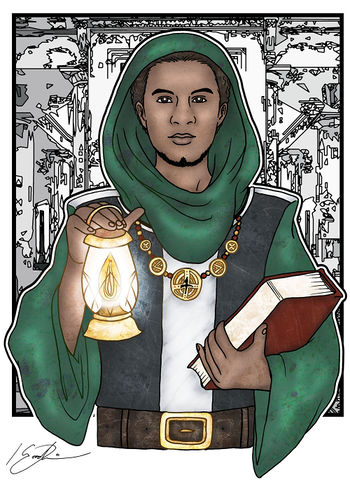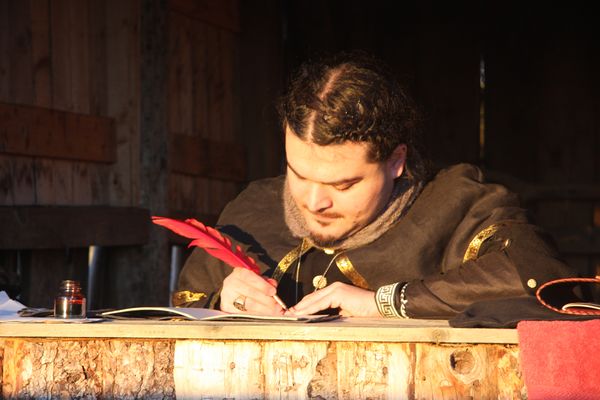Highguard history
The Founding
Seven centuries ago, the Highborn arrived on the Bay of Catazar. Seventeen great vessels carrying pure souls crossed the sea from the south looking for new lands. They left behind a land and people slowly being consumed by corruption and darkness. They were steered by the legendary navigators, a pair of visionary twins named Atuman and Atun who were later acknowledged as an Exemplar of Ambition and a Paragon of Wisdom respectively.
Upon landing, Atuman founded the city of Pharos at the mouth of the river Couros. Atun – following a vision of her own – took the flagship, bade her brother farewell and set sail, never to be seen again. The navigators of the first vessels formed a Patrician Council to advise Atuman the Navigator. The Highborn armada was made up of seventeen ships, three were lost and one was navigated by Atun and Atuman, so the Council was made up of thirteen members.
Some scholars question whether the use of the word "ships" is correct at all - it is more likely that rather than individual vessels the term applies to a number of ships owned by an extended family and led by an individual that came to be called a "navigator". They point to the difficulties of imagining an entire nation coming into being from just thirteen ships' worth of people. Regardless of the questions around precisely how many vessels came to the Bay of Catazar, the number of people on the Patrician Council is not contested.
The Highborn fleet carried with them a great herd of horses. These legendary beasts embodied noble virtues of loyalty, strength and dignity. Mounted on their mighty warhorses, the Highborn were unbeaten in battle and the creatures became the iconic symbol of the nation, reflecting the martial spirit of the people. The venal ways of the patricians caused the herds to dwindle until none remained and since the dawn of the Empire they have passed into legend. Highborn parents tell their children the tale of the loss of their horses to teach them never to take blessings for granted.
The Rule of the Patricians
After Atuman's death his eldest daughter, Acenath, took the title of navigator and ruled in his place while the patricians also named heirs from amongst their offspring. The council ruled wisely for many years but as the generations passed the navigator and the patricians became increasingly focused on preserving their power and their bloodlines and their rule fell victim to self-interest and corruption.
Each patrician (and the navigator themselves) was responsible for appointing their own successor, usually one of their own children, almost invariably a close blood relative. Wealth and power in Highguard was primarily concentrated in the hands of the patrician councillors and their families. Those Highborn with a familial connection to a member of the Patrician Council could usually count on the Council's patronage and support bringing them benefits and privileges unavailable to others. These extended families are also referred to as patricians in many documents of the time, the term being used to refer both to the thirteen members of the Patrician Council who advised the navigator, and to the entire class of nobility descended from them. Some modern historians attempt to differentiate between the two by referring to the patrician councillors and the patrician class to avoid this confusion.
Beyond the ruling council and their immediate families, an entire class of patrician nobility grew up over time. These noble families were wealthy and well-connected but were essentially disenfranchised; in theory any of them might be inherit a seat on the Patrician Council but in practice never did. Most members of these families vied for the favour of the Council, supporting them in the hope of gaining favour. Those who openly opposed the Council risked persecution, financial ruin or even arrest.
Throughout early Highborn history, the power of the Patrician Council waxed and waned. Sometimes the navigator was able to wield more power than the Council; at other times the councillors effectively ran Highguard. The last navigator, Permion, came at the end of an extended period of domination by the Patrician Council, perhaps giving some explanation as to why the Council's response was so extreme. By the end of the civil war, the majority of the councillors were dead and those who survived were either executed, exiled, or bound to dire oaths to set aside their claim to rule Highguard. The genealogies of the patricians were destroyed, and for several decades it was a mark of shame to claim to be able to trace one's line of descent back to a patrician family. Today, even the names of many patrician families have been lost.
The Diaspora
After establishing themselves in Pharos, the Highborn expanded west into Casinea and north into Bastion. The patricians claimed great swathes of land, using the protection they granted to the people who lived in these new frontiers to further cement their position as the rulers of Highguard. Wherever they encountered orcs, they drove them from their lands, put them to the sword, or enslaved them. Some pressed even further north into what is today Reikos, but there the Highborn encountered a powerful and vicious orc nation, their numbers bolstered by the clans that had been driven from Pharos and Bastion, and northern expansion slowed and eventually stopped.
In theory the rule of the Patrician Council extended throughout Highguard, but in practice it was concentrated in Pharos - the city where the Council lived and met. The further from Pharos you travelled, the less concerned with its machinations and edicts people became. Those who were least in favour with the Council were often at the forefront of the nation's expansion, as they sought to establish themselves and prosper away from its corrupt rule. Two such disgruntled families, the Saravos and Tassata, led expeditions as far from Pharos as they could, establishing the towns that still bear their names, in Sarvos, Mestra, and Regario.
Later still, amid first stirrings of the political turmoil that would become the Highborn civil war, three influential patrician "sisters" - known today as Riqueza, Erigo, and Guerra - spoke out against the corruption of the age. They decided to leave Highguard entirely and gathered their households around them resolving to find a new home. In time they, and those who heard their offer of a new life free from the stifling traditions of Highguard, established themselves on the western shores of the Bay of Catazar and founded the Brass Coast.
The Revelation and the Civil War
During this time, trade with the Navarr introduced the Highborn to vinum, a herb which was used medicinally and recreationally. However, the Scions of Atun, a group of ascetics and mystics, discovered a process of refining into a substance called liao. They used liao to experience visions, and in other ceremonies, that revealed the Labyrinth of Ages. This enlightenment, about the immortal nature of the human spirit and the power of virtue, sparked a period of time now referred to as the Revelation.
The Revelation stirred a spiritual yearning within the people and swept across the land, awakening many to a new and profound understanding of life. This awakening was further fuelled by widespread disillusionment with the venal ways of the patricians. The Scions and other groups born of the Revelation left Pharos, sickened by the corruption that riddled the city. Along the borders of the nation they built their own communities, called chapters, each dedicated to teaching a profound way of living inspired by the Revelation and guarding against corruption.
As the chapters grew, the patricians became jealous of their influence and passed laws to try to control them. Things came to a head in the time of the Navigator Permion, who later generations would call the Lawmaker – a navigator who strove to serve the people rather than his own interest. Permion sought to reach out to the leaders of the chapters, starting with the most influential, Lepidus of the Seven Stars. Lepidus is now acknowledged as a Paragon of Pride. He taught Permion about the greatness of the Highborn, what they had been and could be again, and helped him find the will to oppose the wickedness of the patricians.
Permion the Lawmaker's judgements and actions brought the patricians into conflict with him and also with each other. Rather than allow the nation to fall into anarchy, Permion declared martial law and dissolved the Patrician Council. In its place, he invited the chapters to form an Assembly of the Virtuous to advise him.
The response of the Patrician Council was swift and bloody, and a bitter civil war ensued. Permion was assassinated, along with his wife and three of his four children. Various patricians tried to claim the title of navigator, and chaos reigned. Eventually the Assembly was forced to act. After mobilizing the military strength of the chapter-houses it crushed the remaining patrician forces and assumed the governance of the nation, although in the process the city of Pharos - the scene of the final battle of the civil war - was burned to the ground. This tumultuous time in the history of Highguard is remembered in countless stories and songs, and gave the victorious Assembly of the Virtuous many of their new paragons and exemplars including Permion, Exemplar of Courage; Lepidus, Paragon of Pride and Ruth, Exemplar (or perhaps Paragon) of Loyalty.
Rebuilding
The Assembly of the Virtuous elected to turn the ruins of Pharos into the Necropolis, a great mausoleum to house the bodies of all those slain in the war. They also ordered the construction of Bastion, a new city which would serve as a civic and religious centre for the Highborn thereafter and vowed that no Highborn would ever war with other Highborn again.
Over the next few decades, the Assembly united the people of Highguard and reached out to the exiles in Sarvos, Tassato, and the Brass Coast. The city-dwellers had chosen to secede form Highguard during the civil war, claiming independence. To their surprise, a loose alliance of western émigrés banded together to resist Highborn attempts to bring them back under the aegis of the Assembly. In time, treaties were signed and peaceful trade established, but it would be many years before the Highborn finally accepted that the western nations would not see the wisdom of reuniting with their parents.
There were other conflicts; with the orcs to the north-east, with the enigmatic magicians of Urizen to the east, and with the people of Dawn who had established themselves on the shores of the Semmerlak far to the north. Many Highborn chafed at their inability to expand their nation further, to conquer their human neighbours and crush their orc opponents. In the end, however, the Assembly of the Virtuous achieved a different kind of victory as missionaries and wayfarers slowly spread the true faith of the Way to the neighbouring nations.
Imperial History
The First Empress was Highborn, and the last to ride a legendary Highborn steed. After taking liao, she revealed that all human souls are re-incarnated on the same wheel, regardless of whether they were Highborn. Therefore, to preserve the future of Highguard and enlighten all worthy human souls, it was essential to unite all of humanity under a single banner, such that Highborn reborn elsewhere would still come to know their heritage and the Way of Virtue. From Highborn faith, the Empire came into being, changing the face of the world forever.
As a consequence, many Highborn view the Empire as their child; a wilful child that often does not know what is best for it. They were instrumental in helping to establish and build the powers of the Imperial Synod, most notably during the time of Empress Teleri where Highborn priests and cardinals worked alongside the Navarr Throne to help define and exercise the powers of the faithful. They have worked hard over the centuries to keep the fragile alliance of nations together through the Imperial Senate, and resolutely supported the expansion of its borders by the Imperial Military Council. Likewise, Highguard has worked hard to keep the Imperial Conclave focused on its role as protector of the Empire - in particular a significant number of prominent grandmasters of the Sevenfold Path order, and archmages of Winter have been Highborn. Perhaps the only place where their influence has been blunted is in the Imperial Bourse; the natural Highborn suspicion of economic factors has often left them frustrated that the ruthlessly pragmatic wealth-seeking nature of the Bourse does not perform more virtuously.
Highborn on the Throne
Aside from the First Empress herself, two other Highborn have occupied the Imperial Throne.
Empress Aenea was appointed in 103YE, and instituted a wide-scaled program of public works. Among other things, her reign saw the creation of the Lyceum - the Empire's premier college of magic; the creation of many roads and highways still in use today; the construction of several fortifications; and a general overhauling and refinement of the Bourse, the Senate, and Imperial law. Her reign is also marked by conflict - she had little interest in foreign affairs, being focused entirely on building and strengthening the Empire.
Emperor Barabbas took the throne in 180YE, and like his predecessor he focused on strengthening and expanding the Empire. Unlike Aenea, whose interests were very much in the land and its structures, he was fascinated by the sea. An ambitious and charismatic man, he had a vision of an Empire that dominated the entire Bay of Catazar. He is best known today for the manner of his death - lost at sea during a terrible storm along with the great armada he had nearly bankrupted the Empire to create. While modern historians are not kind to Barabbas, the Highborn are often quick to point out that his reign was also a time of great Imperial Ambition and a period of expansion and improved emphasis on securing diplomatic relations with foreign powers.
Archivists
Highguard looks to the past to understand the present and predict the future. Its scholars, priests and wizards thirst for tomes and artefacts that reflect on the Empire. There is a roaring trade in books, scrolls and tablets, the more obscure the better. While relics of the holy prophets or antique magical articles are valuable in and of themselves, high prices are also paid for tangible evidence of past life experiences.
Archivists collect the histories of Highguard, and of the Empire. They see history as a story that exists not to record dead facts, but to inspire the living. As a consequence, facts that undermine the central truth of an event or the life of a historical character are actually dangerous. A new fact that suggests a wise historical judge never existed, or that a brave general was actually a coward, could do irreparable damage. It could destroy the faith of the living in the individual hero but also undermine the very idea of learning the lessons from history. Destroying or discrediting such lies is as important as revealing the facts that encourage and inspire the living.
This means the Highborn archivists are often at odds with their counterparts in other nations, especially the Urizen seers and torchbearers. In recording and publicizing “facts”, without applying any moral judgement, Urizen historians deny the inspiration offered by history and its role in making the present and the future better. A common rumour suggests that Highborn archivists maintain hidden storehouses of knowledge deemed too dangerous for the common people. This rumour is baseless. If a piece of information uncovered is considered dangerous to the Empire, it is destroyed so that no future generation can be harmed by its rediscovery.
Archivists are romantic figures in Highguard. While the truth is that many of them are quiet scholars and scribes, the popular image is of them as active, energetic people who go to dangerous locations to retrieve valuable information or artefacts for the good of the nation and the Empire as a whole. They face danger frequently, and often have to work against those who want to foolishly spread dangerous information or unleash deadly magic.
More Highguard History
- Horse - Discussion of the Highborn horses.
- On the Doctrine of Human Destiny - Historical research relating to the origins of the Doctrine of Human Destiny that also discusses some Highborn history
- Origins of the Highborn - Document compiled by scholars visiting the Sarcophan Delves regarding the origins of the Highborn people.
Further Reading
Core Brief
Additional Information


